Harley Exhaust System Design
Not using free energy to help your engine make more power is just plain stupid. High pressure and low pressure...it’s that simple. What your engine “sees” when the exhaust valve is open will determine whether you win or lose. Of course, things are never really that simple, but, that’s really what exhaust design is really about. When the exhaust valve opens two events occur as a result of the combustion set into motion by the ignition of the compressed air/fuel mixture. Everything happened after the Big Bang,....whoops! For some of you we shall simply state that God created Harley...and then while he was sleeping the Japanese sneaked in the door.
The jet photo has nothing to do with Harley
Exhaust Systems but it does show the power of sonic waves, in
this case as the A/F18 in transonic flight. Right
photo is a high velocity LSR 2-1 Pro Stock Challenge
00-1306 on a 9 second Harley FXDR.
Surf's Up ...Catch a Wave
First, a sonic wave heads down the pipe at about 1600 feet/second (about 487 meters/second). Secondly, the hot expanding gases head down the pipe at about 300 feet per second (91 meters/second). The speed of these gases will be determined by the diameter and shape of the primary tubes and the temperature of the exhaust.
The loss of temperature as the exhaust travels down the exhaust will slow these speeds. The mathematical solution is that this velocity varies directly with the square root of the ratio of the absolute exhaust temperatures. To keep this simple, it just means cooler is slower. Those really long fat pipes you see are decellerating the exhaust as they head out past the rear wheel.
People go to “ugly lengths” to wrap their exhausts
in thermal blankets to keep these speeds “high”. While this
might seem to be logical, we do not think it is worth the
trouble. A better solution is to thermally coat the system with
a silver ceramic finish. This will keep the internal
temperatures higher that if the exhaust was chromed and it looks
a hell of a lot better that “The Mummy Returns” tape routine.
Primary Tube Design Considerations
We said the primary tube size is important to
these gas speeds. Keeping things simple, this is summed up as
“the larger the tube, the lower the speeds”. For the expanding,
hot gases a slower speed means a higher pressure and,
conversely, a higher speed is a lower pressure.... Bernoulli
explained this mathematically for us a long, long, time ago.
Generally we want a lower pressure and a higher speed in the
exhaust. Having a highly negative pressure in the exhaust during
the overlap period when both inlet and exhaust valves are open,
is the key to making power. Design will influence this but, in
regards to the primary tube size, we can simplify things a bit.
The primary tube size will go up in relation to engine size. The
size of the tube should be slightly larger that the exhaust port
area which, in itself, will most likely be “D-shaped”. The
“D-shape” flattens out the floor to the port to increase the
flow on the “short” side or floor of the port. Having the tube
size much larger than this “slightly larger” is no benefit
whatsoever. Simply put, an increase of of 1/4” in diameter will
shift the rpm band up about 300 rpm for the same size engine.
RB Racing makes two basic diameters of primary
tubes...LSR 2-1 designs in both 1 3/4” and 2”. Your original
Shovelhead and EVOS were 1 3/4" as are the OEM M8 Harleys...
V-Twin engines have gone for 74 inch to 132 inch and larger...A
58hp 80" EVO does not use the same primary tube size as a 135 Hp
M8.
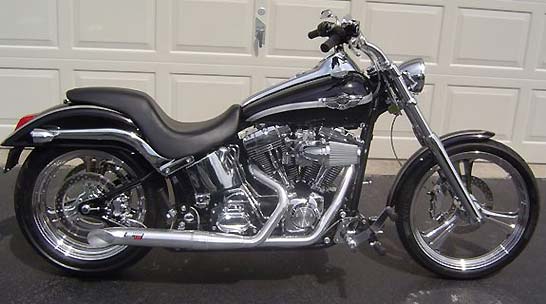
Decisions as to what tube size to choose aren’t very scientific but are based on experience. We can sum this up in Twin Cam terms: 88”, 95”, and even 103" motors should use 1 3/4” primary tubes. If the engine is a 103” TC88 you have a choice between the 1 3/4” and the 2” designs. The decision for the 103” rests with your intentions and the design of your engine. The 103" motors generally do not make much power, about 80 hp, and are limited by valve size and reside in a heavy 800 lb sled. In general, stay with the 1 3/4" design. Now there are 110", 113" engines that are focused on horsepower with inlet valves 2.100" or larger and with 200lbs of cold cranking pressure or more and big cams. In this case a 2" primary tube design is called for.
For EVO engines we have a basic standard: If it's over 100 cubic inches we go to a 2" pipe. Even a high performance 96" S&S motor can run a 2" pipe because they have better flowing cylinder heads.
For Twin Cam engines below 120" the decision is is
based on state of tune and riders' intentions. For Twin Cam
engines 120" or above go directly to a 2" design. The popular
124" S&S engine definitely needs the 2" pipes.
All of our M8 use 2" primary tubes.
Physics, Baling Wire, and Lineman's Boots
We need to get back to those hot expanding gases
headed down the pipe at 200 to 400 feet per second and those
sonic waves traveling 1500 to 1700 feet per second. These two
events are going to be there whether we like them or not so it’s
a good idea to see if they can be used to any benefit.
It’s easier to visualize a 300 foot per minute mass of hot
expanding gases than a 1600 foot per second sonic wave so let’s
start there. When the exhaust valve opens there will be an
instantaneous positive rise in pressure in the exhaust.
Following this mass of expanding gas will be a negative pressure
(vacuum) which helps evacuate the spent gases from the
combustion chamber.
If we have a 2-1 system this positive pulse will “hit” the
larger diameter collector causing a vacuum signal in the other
primary tube. In as much as a whole world of 15 psi atmospheric
pressure is patiently sitting at the exit of the tail pipe,
these vacuum or negative events are welcomed by the poor
antiquated V-Twin, as it has enough trouble breathing anyway.
Another way to look at it is that we have a soda straw...at one
end is 15 psi and the other end is a vacuum. In this case the 15
psi is sitting outside your throttle body or carburetor and the
vacuum is in your exhaust pipe. It is clear that having a low
pressure event on the ass end of things can help the equation.
These are just air pumps and they need help.
The faster sonic wave acts in the same manner sending a signal
down the exhaust pipe which, in the case of a 2-1 system, will
cause a reflection back up the primary tubes as it enters the
collector. These reflections can help your engine breathe by
creating a lower pressure at the exhaust valve.
With all these waves bouncing around the matter of their timing
is really the million dollar question. Unfortunately this gets
terribly complicated as header diameters, primary tube length
and shape, collector design, tailpipe design, exhaust
temperature, and a dozen or so other variables all get their
shot at changing things. There are some general guidelines we
can offer however.
The first guideline is not to pay any attention to the crap the
marketers dish out because they would sell you an 18 wheeler
exhaust stack if they thought you’d buy it. The second thing to
ponder is that most decisions are irrational, and are based on
emotion or fashion, so most people are going to go with the flow
or flavor of the moment...megaphones, thin-wall stainless,
machined butt plug end caps.
The plight of the consumer in a product driven
market where Monster Garages and hard nipples form our product
ideas. So much for rugged individualism. Heaven help the person
who makes a decision without considering what others will think.
Highway to hell on the social register.
The Search for Something besides Bullshit
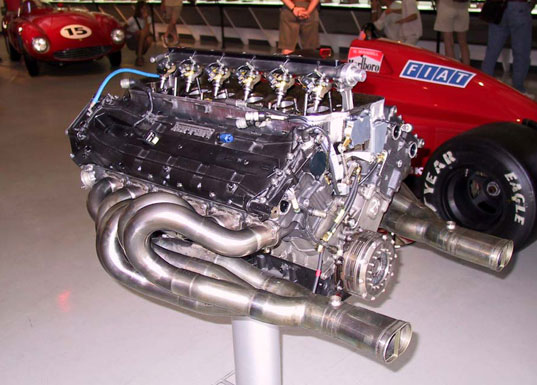
Best look at exhaust systems that no one is trying to market to you if you are considering performance. A place where they are spending hundreds of millions of dollars trying to squeeze horsepower out of an internal combustion engine, and where they aren't trying to sell you some billet trinket, is probably a good place to start to find some answers to these exhaust questions. Let’s look at some of these examples. Pictured above is an early Ferrari V-12 Formula 1 engine.
In the rarefied world of Formula 1 they get over
four horsepower per cubic inch without any turbo or
supercharger. If you could do this with your Harley you would be
driving around a 350hp street bike. This might be a good point
to start looking. These are three liter engines or about twice
the displacement of your average Harley-Davidson. They also rev
about three times higher or about 18,000 rpm and they have much
shorter strokes. In spite of these differences it is a given
that the designs have been optimized way, way, beyond the scope
of your usual “It fits in the box” Harley exhaust system.
We should point out that F1 rules prohibit the use
of variable length exhausts, otherwise they would have this as
part of their equation. Take a look at the photos. All employ a
form of a merge collector which simply means the primary tubes
are joined in a sort of pyramid shape that has an internal spire
that eliminates the dead spot or high pressure area formed at
the center of the primary tubes grouping. Since your Harley has
but two primary tubes we have to go to a 15 degree merge
collector.
No Megaphones...Merge Collectors
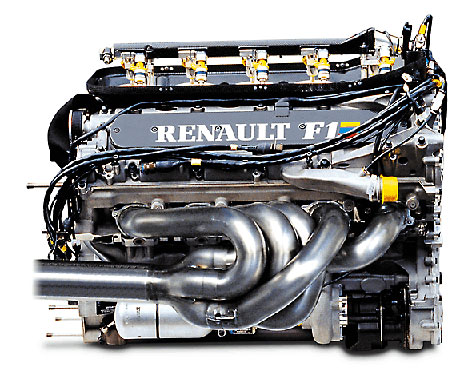
The second thing you notice is that the tail
section of a F1 exhaust does not have any megaphone and that the
flow at the exit of the merge collector is but a few sizes
larger than the primary tubes themselves. You will also notice
that after the pipes collect there isn't a very long tail
section. This brings up a difference that occurs when you try to
“merge” five tubes on one side of a V-10 F1 Engine as opposed to
two primary tubes on a Harley.
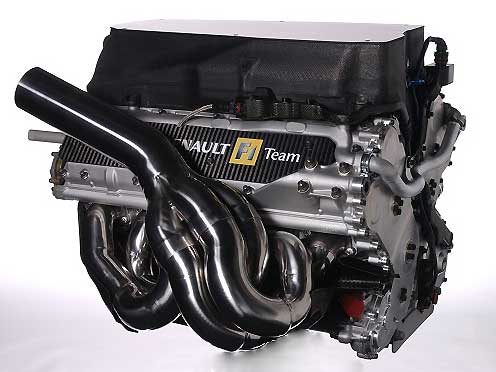
In the case of the F1 exhaust designer he has to, fairly abruptly, end the collector to minimize collector volumes to keep the velocity and wave scavenging at a high level.
Pictured above is a Renault F1 V-10 3 liter Formula 1 Merge Collector System. These are made out of very thin Inconel sheet that is formed into short tubular sections and welded together with the tubes slipping into upset joints at the merge collector. Note that the final exit is but a few sizes up from the primary tube diameter. 2005 World Champion. About 5 horsepower per cubic inch...no turbo. 19,000 rpm. Pneumatic valve actuation..no valve springs.
Inconel 625 Laser Sintered Merge Collector F1 Ferrari
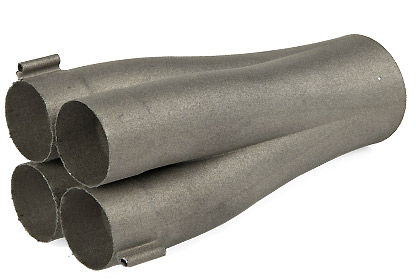
One side of the 18,000
rpm V8 Ferrari merge collector. Laser sintered not bent,
hydro-formed or welded.
Megaphones We Ain't Got No Stinking Megaphones
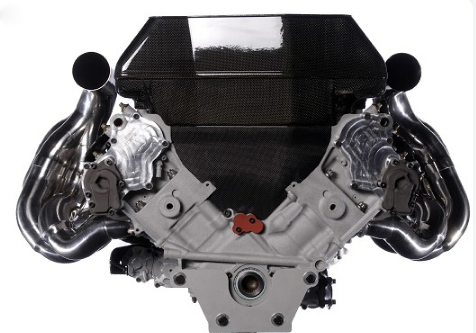
No anodized aluminum butt plugs. No reverse lip megaphones. Just your 2006 V8 World Champion. What does this have to do with your 100 year old antiquated pushrod Harley...Well, just about everything because engines are engines and we love engines. Let the metal scream. Tire spinning, 1450 deg F exhaust temps, headers glowing dull red, valves about ready to float, pushrods deflecting, poor primary drive about to twist sideways...the metal serves us, we don't bend to it. Someone has to be in charge. This isn't a "Park and Talk" game. Someone has to lose. Limits have to found.
LSR 2-1 Challenge Pro Stock Exhaust
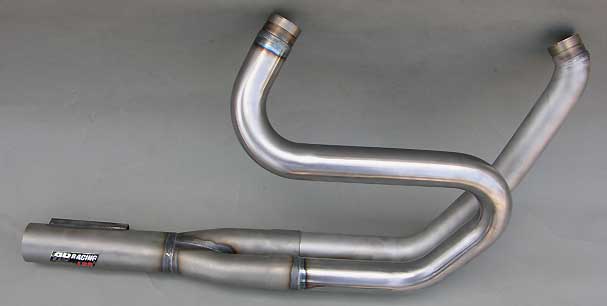
Merge collector with large 2" diameter primaries and a short 2.5" secondary. Available for either standard (2 stud) ports or for big valve B2 and earlier SA (four bolt) cylinder heads. Unlike the Renault 18,000 rpm motor, our 6000+ rpm long stroke Harley gets longer primary tubes. Part number 00-1306. Available in silver ceramic, dual-coat black ceramic or chrome finishes. Specify chassis for appropriate mount systems.
Sportster 2" Challenge Pipes
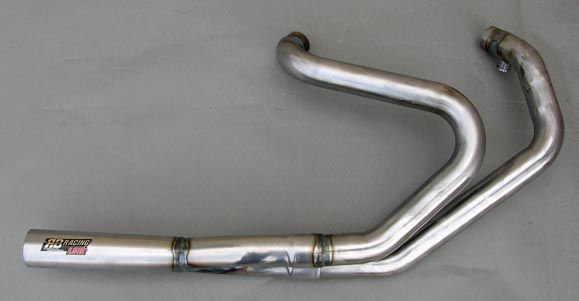
00-1306 Sportster LSR 2-1 Challenge
Pro Stock Exhaust with 2" primaries. This one is being
instrumented for a RacePak Data Acquistion sytem with EGT
probes as well as with our O2 outputs. Tuning is done with our
RSR Air Fuel Ratio Gauge. Generally
these were only used on 100" S&S SA case rigid Sportster
engines
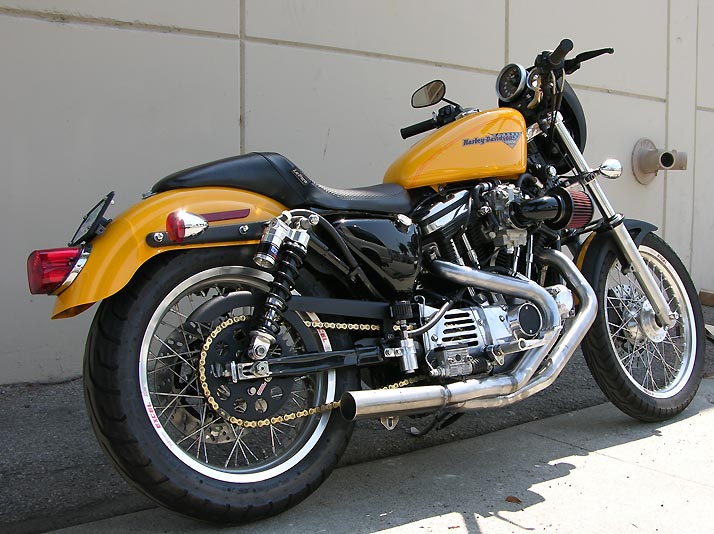
S&S Cases .250" wider than stock with a 100 Inch 4.00" x 4.00" combination. Branch O'Keefe heads and a serious 132 horsepower. Pipe clears brake pedal and tucks under master cylinder at a 45 degree angle. Pipe is set up for two oxygen sensors and is about to be sent out for a 2500 degree, dual coat ,semi-gloss, black ceramic finish.
Special order 2" LSR 2-1 Pro Stock 2" Sportster Challenge pipe 00-1306. The bike belongs to Paul of Branch-O"Keefe the famous cylinder head specialist firm founded by industry legend Jerry Branch. In 1977 Jerry ported the cylinder heads for our 24 Hour Endurance Racing bikes...things come full circle.
2005/2006 Champion
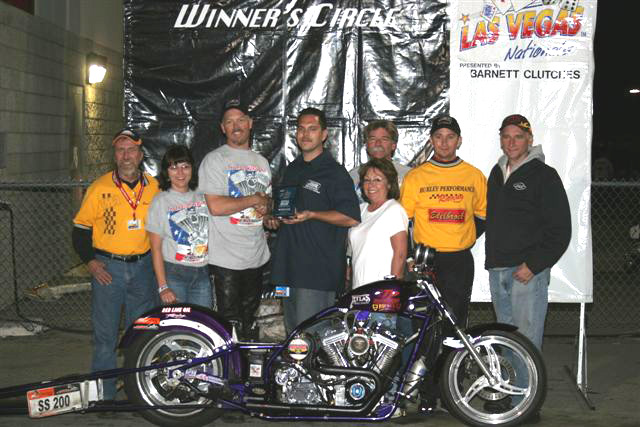
Joe Boyd won the 2005 AHDRA S&S Super Stock Western Division Championship with his Challenge pipe on a 113" motor. The pipe dropped his E.T. three tenths. He repeated the feat in 2006.
Lynchburg Harley-Davidson has been getting 138hp and 145ft/lbs of torque on 117" TC88 street motors with these exhausts.
"Challenge" pipes can be made for most models but they all carry the 00-1306 part number.
LSR 2-1 Pro Stock Challenge RSD
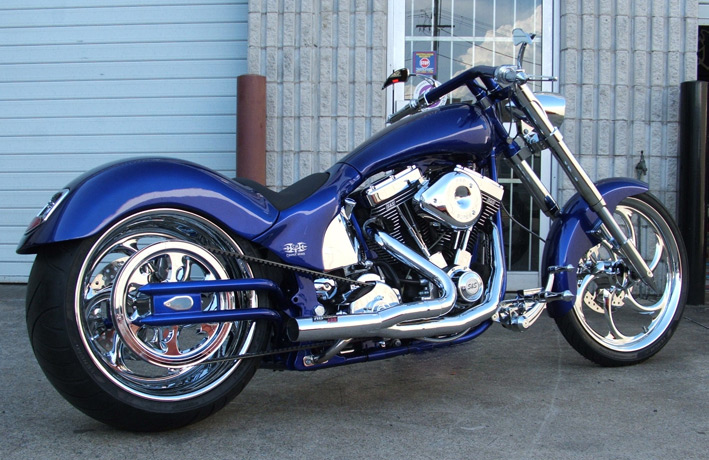
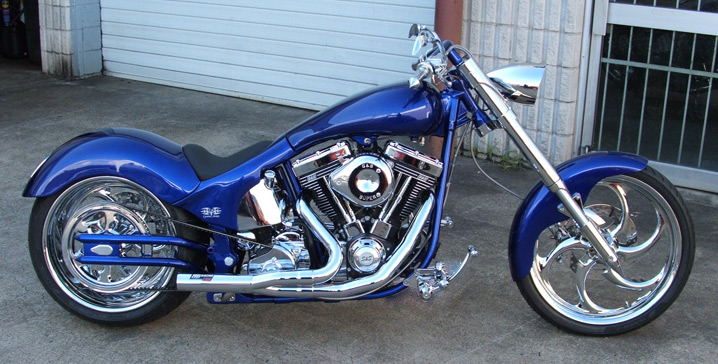
Sort of "Show and Go". Not exactly
a practical day to day rider. More of a Park and Talk. At
least the exhaust is serious. Can't go wrong with an S&S
engine.
Street Pro Stock Systems
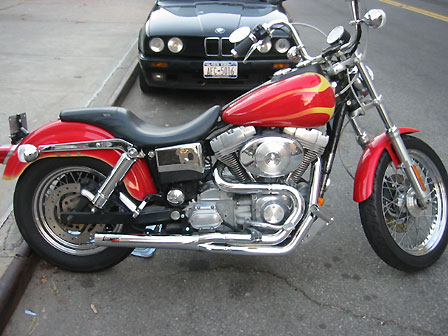
The Harley merge collector does not face this problem and the merge angles can be less severe. RB Racing uses a merge angle of 12.5 degrees on the LSR 2-1 Pro Stock unbaffled 2.5" tail section designs. In our LSR 2-1 baffled pipes with their 3” tail sections we accomplish the merge with an hourglass shaped muffler core which has the flow characteristics of a single 2” primary tube. The hourglass shape forms a venturi which, in turn, sends back a low pressure signal to aid in the scavenging. The two primary tubes either 1 3/4” or 2” enter a “collector” which is really just the 3" tail section diameter...and the merge is done internally with the baffle to provide some sound attenuation. Tricky stuff. It's the internal shape you have to be concerned with.
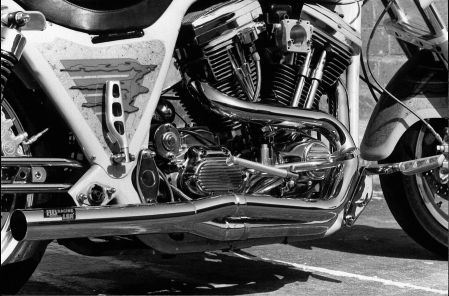
Length and diameter is an issue. To put it simply,
longer, smaller primary tubes for lower rpm, and shorter, fatter
tubes for higher rpm. In the case of engine displacement a
smaller engine requires smaller primary tubes and a larger
engine requires larger primary tubes. Putting too large a
primary tube on an engine will shift the torque up the rpm
scale. It all has to do with the length and volumes of the
tubes.
When you are hunting for Horsepower you maybe should turn in
your hunting license and get a fishing license for Torque. The
Formula 1 engine operates in a narrow regime in the 15,000 to
18,000 rpm range, whereas your 6,000 rpm engine will spend most
of its life in the 2500 to 3200 rpm range, with most shifts
occuring at less than 4,000 rpm and immediately falling back
into this 2500 to 3200 rpm band...this is where the torque
should be for most people.
We have had customers running our 2" pipes on smaller engines
who say they are getting killer horsepower but that they would
like their powerband "to start at 2700 rpm instead of 3200 rpm".
A high performance engine with high lift cams with enough
overlap to breathe well at 6400 rpm cannot be expected to pull
like a tractor above idle. A Japanese crotch rocket will go like
a bandit from 6,000 to 10,500 for a 1100cc motor or maybe 9,000
to 14,000 for a 600cc motor. You just can’t have it both ways.
Does Length Matter...Well, Someone had to ask

Primary tube length is always a quandary on Harleys because they are not 90 degree or 180 degree engines and with their siamesed crank and close firing order coupled with the fact that feet, forward controls , foot pegs, floorboards, and legs get in the way, we are going to have to deal with compromises. When you start with a 100 year old air pump, compromises come with the territory. Primary tube lengths are going to be restricted to the region of 20” to maybe 40”...above or below this things just don’t fit. Beyond these lengths it’s just too long. So length does matter.Then there's the question of diameter...we'll get to that later.
Mathematical Simulations and Practical Solutions
Running simplistic calculations on lengths is pretty much a waste of time beacuse you are dealing with a fairly wide rpm range and like we said earlier, if the Formula1 guys were allowed to, they would make variable length exhaust systems. Go-Karts do it and have done so for a long time. In short, you have to design for what you are going to do. If you are running a 160” Pro Stock Bike then you might as well build a set of large diameter (2.250") equal length 20” primaries going into a merge collector with a tail section (2.5") 10” long after the collector. This will be a peak rpm animal, with little time between firing events, compared to a street engine. For your lower rpm street bike you are going to have to do something with longer primaries.
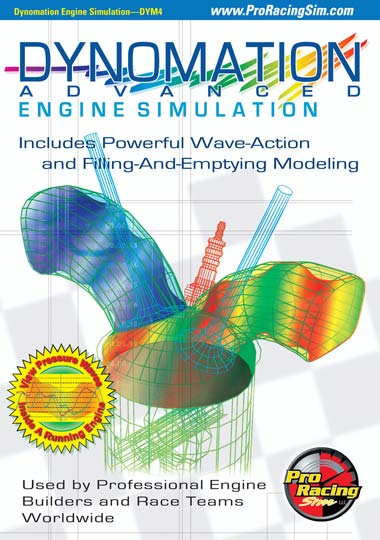
If you want to really get into this simulation
business there are cheap ways and then there are expensive ways.
It is a case of you get what you pay for. At the free end of the
cfd scale is Viziflow.
At the low price, commercial end of the scale is Dynomation 6. At the high end of
the scale is WAVE Software from Ricardo. At RB Racing we
have a lot of practical, historical data and often tailor our
designs for specific racing projects based on experience and not
on simulation. Plus testing on our Superflow Dynamometer.
When we approach a complex project where we lack experience or where testing will end up being short-changed we do simulations first. Matching camshafts to exhausts is a perfect example of this.
Should all Primaries be Equal?
Then there is the question of front and rear
primary tube lengths and the eternal question of “equal length.”
Here we offer some facts and figures:
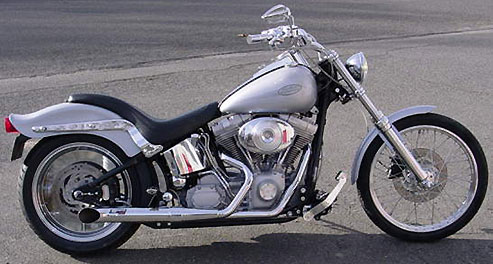
Our typical “C” Style Softail /FLHT pipe has front
primary tubes about 25” long and and rear primary tubes about 23
“ long. The rear pipe has some sharper bends so with the added
restriction it flows about like the front pipe. You could say
these are equal length and we would not argue.
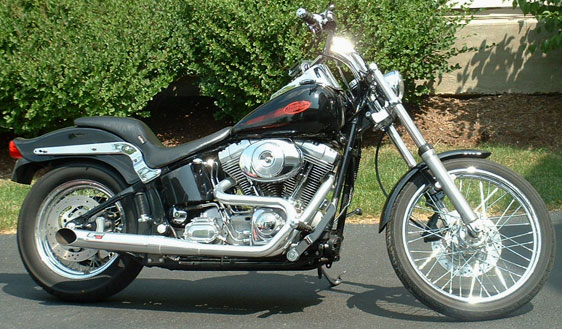
On the other hand we also build “B” style pipes
and a 2” or 1 3/4”version set up for a Softail will have a 25”
long front primary tube and about a 37” rear primary tube. The
rear pipe has more bend degrees so it is actually a lot
“longer”. Generally the “B” style will produce more torque with
the longer primary tubes, but this is also influenced by
camshaft timing and air fuel ratios. Camshafts with exhaust
closing events later than 40 degrees ABDC will “blow down” a lot
of your compression and low end torque to gain peak rpm
breathing capacity. In addition, camshafts with narrow lobe
centers i.e. less than 108 degrees, on the average, will have
overlaps biased to high end horsepower. It’s never easy.
Your 45 degree V-Twin is a bag of compromises, and, in the case
of our “B” pipe, we try to take advantage of the long period
between firing events by delaying things a bit with the longer
rear primary.
Lengths for the individual runner can be as little as 20” for
absolute peak rpm tuning to a more manageable 37" or so for most
applications. Internal shapes in terms of baffles, expanded
sections etc. will all have an effect on tuning. One thing is
for sure, however, and that is, from a purely theoretical
standpoint, a 2-1 will provide more usable torque. Once again,
primary tube size has a large effect on the system. If you go
too big, the low end will fall off the charts.
People ask us how long are primaries are...We tell
them the pulses are individual and the length F/R is from the
port to the exit of the baffle, or in the case of the LSR 2-1
Pro Stock the port to the end of the secondary pipe post the
merge collector. That sort of goes over most people's heads.
Tuning and Development Stories
Back in the 1980's we developed a 38mm Flat Slide Carburetor off a Mikuni casting that was only used in Japan. We called it the "PowerMaster". Mikuni American Coropration was sort of upset about this and wanted to take over the project, but Mikuni Japan told them to let us do it. We added an accelerator pump that we manufactured and got the Shoveleads and EVO's working well and, at one point, even developed an electric automatic choke mechanism as people were too lazy to pull an enrichening knob. Mikuni American Corporation simply doubled our prices for the castings from $70.00 to $140.00 after we sold several hundred carbs so we dropped the project. Since we had all the data, Mikuni USA asked us to develop a 42 mm Flat Slide for the Harley Market that was originally made for Vance and Hines inline 4 Jap market. We declined.
Keihin Corporation then asked us to develop the 41mm CR Carb for the Harley Market. We tested the carb on Shovelheads and EVOs getting 54-56 MPG and turned the data over to Sudco Corporation after doing altitude tests to 8000 feet as well as hot soak testing. Kehin actually asked us to do long idle tests with the bikes leaning to the right even though we told them all the sidestands were on the left.
Sometime later we
ordered a 41mm CR Carb from Sudco and took it apart. We called
them up and asked if they had done further testing and , if they
had, what mileage did they get. The answer was yes and they were
getting 37 MPG...We responded "That was what we thought".
We installed the Keihin
41mm CR on new 1995 Dyna with our original needle and jetting
and the customer ran the bike on a 500 mile run. We pulled the
exhaust off after the run and it was perfectly clean inside. He
marveled at the mileage as his friends had to fill up and he
just topped his gas tank off. The bike would pop wheelies easily
with a dead stock engine and could do no wrong. The customer
then took the Dyna to another shop and had some work done and a
cam installed. He brought the bike back to us to look at. We
looked at the exhaust and it was full of soot. One ride around
the block proved the bike was gutless and way out of tune. We
told the guy it ran great as we did not want to get involved.
Usually it's people's
inability to tune. 99% are just parts changers...with an
undergraduate degree in 1/2" and 9/16" wrenches. There is no
science in part changing. Guess who gets blamed...The exhaust
manufacturer.
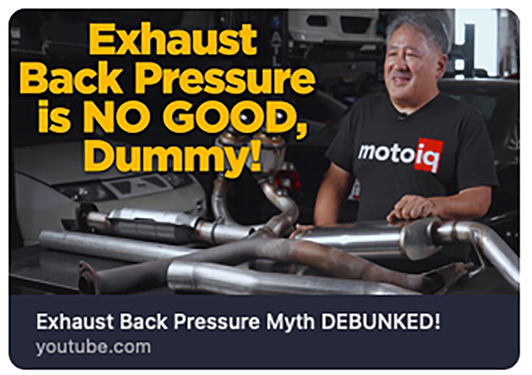
Back pressure Physics
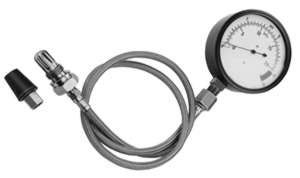
We are going to state this very
clearly...Back pressure
does not increase horsepower. Period. End
story.
An often heard statement from the well-informed is "You need a bit of back pressure for an exhaust to work". Usually this comes from someone who is not a tuner or someone who is faced with a situation where he does not have the tools or means to adjust things. Anything you do in the exhaust will change the flows, the pressures, or velocities somewhat. The correct scenario is that the exhaust has to be properly designed and then you optimize the jetting, ecu data inputs, camshafts, port dimensions, valve sizes and the like. The exhaust has to be designed for the intended use.
This all dates from the early 1980's when Supertrapp invented a muffler designed for dirt bikes to trap potential sparks, or burning, carbonized, bits, so it could have US Forestry Approval for off-road use. The "trapp" tells what the intended purpose was. If you wanted a Harley to barely work you had to stick a couple of pounds, or about 23-25 of these discs in the end of your exhaust. Of course this didn't really work, which is why they ended up putting a hole up the middle anyway. You don't tune an exhaust.
Your engine has 15 psi (1 Bar) of atmospheric pressure sitting at the inlet and another 15 psi lurking at the end of the tailpipe. The inlet stroke creates a pressure differential and the atmosphere goes rushing inward. The exhaust valve opens and there is a pressure rise in the tube followed by a strong vacuum signal as the gases head down the pipe. Note that we said "vacuum signal."
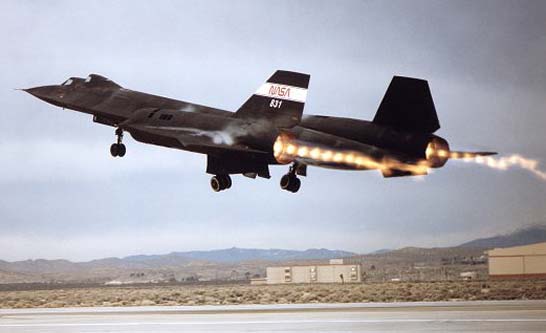
Pressure differentials can be seen in the exhaust of a jet engine. We have a high pressure pulse coming out our exhaust system but it's just not visible as in the photo above.
The pattern of evenly spaced rings sometimes visible in the exhaust of jet engine is typically referred to as shock diamonds or Mach disks. The phenomenon occurs anytime a flow exits a nozzle at supersonic speeds and at a pressure that is different than that of the external atmosphere. Most of us are probably used to seeing shock diamonds occur near sea level during the takeoff of an aircraft, like in the above photo of the SR-71 Blackbird.
Logical extremes are often used to
illustrate a point. For those who argue that back pressure can
be a help they might say, from an extreme position, "Let's throw
away the exhaust system so we have no back pressure at all".
They would then conclude that the motor would run like crap and
we would agree completely. The only problem is that they haven't
gotten rid of back pressure, they simply have introduced 15 psi
at the exhaust port and have given up any inertia, gas speeds or
vacuum signals that exist in a primary tube. More importantly
your gas speeds hit zero with no tube.
The vacuum signal or low pressure that follows an exhaust event can be used to help scavenge the cylinder during overlap when both exhaust and inlet valves are open. Conversely, during this overlap period, the increase in back pressure can cause these burnt gases to re-enter the combustion chamber and contaminate the inlet charge. Result...loss of power.
The proper way to look at exhausts is to view them as a way to maintain the highest velocity that will not impede flow. As velocity increases the pressure drops and the engine can become more efficient. We have all the variables of length, diameter, rpm, collector size, internal shapes and the reflective waves that all this causes. There is no "one answer".
For those of you who disagree because
of anecdotal evidence we would agree with you also. Stick your
finger, washers, or whatever up an exhaust and it will change
things. Altering an exhaust's flow can correct something else
like mixture or spark timing. In the end, if you have to throw
it off a cliff to win, do it. Only results count and if
increasing back pressure helps your situation then do it. We use
baffles that do not impede flow (power) but maintain high
exhaust speeds (lower pressure). People are, by in large, not
tuners, just part changers...We spent years doing drag strip
testing before the land got too expensive to determine the
internal shapes of the exhausts.
People who take our advice and use
our RSR Air Fuel Ratio Gauges to
tune and monitor in the real world get the best results.
As a final thought...Gale Banks doesn't make money selling increased back pressure exhaust systems. Think about it. That picture above is a dedicated exhaust backpressure gauge. We use them and we design our systems for minimal back pressure.
Broomstick Myth
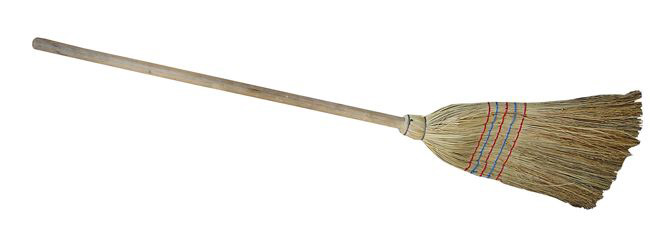
There seems to be a myth
about broomsticks and tuning which goes like this "If you can
stick a broomstick up your exhaust you won't be able to tune
your bike". Well bippies, we went through that more than 40
years ago when the EVOs came out....and well though the development of our own fuel RSR injection up through the high
end Cosworth ECUs we use these
days...not to mention OEM Delphi systems. Forget the useless
Weber Marelli 1998 era Harley ecm.
Go to the drag strip with an exhaust that only bypasses enough air for a 1.0" diameter broomstick and you'll be on the trailer when the engine signs off on the big end (power). This myth continues because of slow reacting Lambda Sensors placed incorrectly in the exhaust system and or control systems using Alpha-N (Throttle angle/rpm) which try to control in real time all the shit that's going on, having too much authority to correct things instead of incrementally learning. Some exhaust system manufacturers place the O2 sensors where they simply are going to read incorrectly. Steve Cole of TTS MasterTune can tell you horror stories about this. Then the "Tuner" then wants to choke up the pipe to stagnate things to get a reading.
We run our Pro Stock systems with no baffles under on closed loop efi systems. No broomsticks and O2 sensors very close to the exhaust valves and get over 50 MPG. At W.O.T. the late model Harley ecms do not look at Lambda and you don't want a restrictive exhaust.
Internal system shapes
will determine when reflections occur. Sticking a slow reacting
Lambda probe up the rear of the pipe only half way to the
exhaust ports is patently stupid. People keep doing in anyway.
Best use our RSR Air Fuel Ratio Gauges
with Lambda sensors at the exhaust ports.
Heat Picture
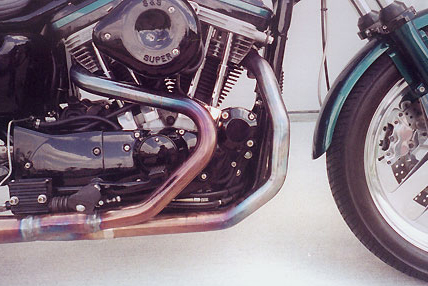
Here we can see on this LSR 2-1 Pro Stock Sportster exhaust how turns influence the build up of heat as well as the energy concentrated in the merge collector. We have to clear things like foot pegs, master cylinders, highway pegs, brake pedals, air cleaners etc. in our search for power. Testing at Blue Springs Harley Davidson...James.
Heat Barriers versus Chrome
Heat is power and loss of heat means a loss in velocity. People make all sorts of claims about wrapping headers in thermal wrap, applying ceramic coatings both inside and out and the heat retention properties of stainless versus mild steel tubing. Let's get real about this issue...You aren't going to measure the difference between chrome and ceramic coatings and it really boils down to a question of aesthetics and practicality.
In so far as wrapping your headers....don't do
it unless you are an Egyptologist and are looking to attract
Nefertiti. It looks like crap and there are moisture and
corrosion issues as well as premature deteriorization of the
base metal. The exhaust system will crack as the metal reaches
a-quasi plastic state as it can't dissipate the heat.

The Silver Ceramic and Black Ceramic coatings RB Racing uses will reduce radiant heat and therefore will slightly have an effect on gas speeds and lessen discomfort a tad if your legs get close to the pipes. Realistically, you still need heat shields as these provide an air gap and air is the best insulator.
The Silver Ceramic RB Racing uses provides a polished finish that is damn near impossible to remove. We pre-polish the parts to remove any bending tooling marks. The headers are blasted with a Zirconia media and sprayed with the Silver Ceramic coating and then baked. After the baking process the headers are burnished in a vat of ceramic beads to harden the surface and bring it to a high polish. The finish luster can be restored or cleaned with Mother's Aluminum and Magnesium Polish.
The Black Ceramic RB Racing uses is a complex
and expensive process. We pre-polish the parts to remove any
bending tooling marks. The headers are then cleaned and baked
to 600F to remove any moisture or oils. The headers are
blasted with a Zirconia media and a 2500 Deg F Silver Ceramic
base coat is applied. The headers are then baked again at
600F. Finally a Semi-Gloss Ceramic Black finish is applied and
the headers are baked again at 600F.
This leaves us with chrome. It has the hardest surface, is certainly the most brilliant, and as we stated before, you could not detect a performance difference if you tried. It all boils down to aesthetics and rider preference.
Torque Cones...WTF
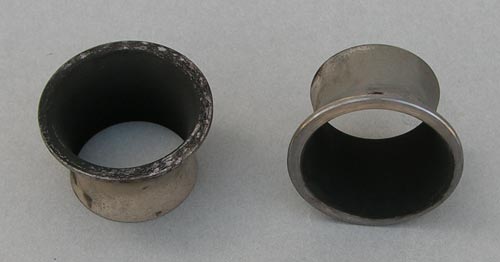
Torque Cones are most often found hiding in some "master builder's" wazoo custom pipes. Usually full of soot due to poor fuel control they are an attempt to get the carb to work with the out-sized, swoopy fat front primary tubes, usually big radius copies of somebody's work. These kill power and should be thrown away if you put a decent exhaust system on the engine. Too much TV.
Stepped Headers..For Clowns

An interesting issue is the buzzword “Stepped Headers". This is a situation that is sort of like a runaway train in a Hollywood movie with John Voight at the controls...It is hard to stop and question it once it gets rolling. What we really need to think about are the volumes and any changes inside the primary tubes. A stepped header made of of three, four, or five next size up tubes, welded together, is just a marketing game.
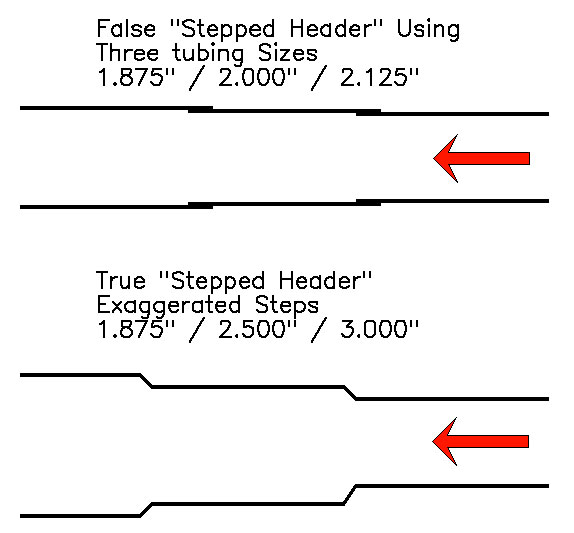
Simply welding together
"next size up" tubes to produce "steps" leaves 90 degree ledges
that disrupt flow and cause turbulence affecting the mass flow
rate...not exactly what people claim.
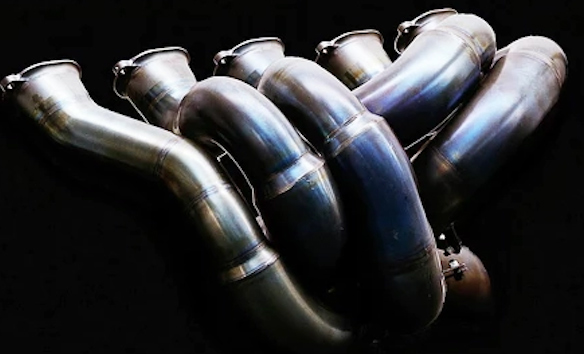
True "steps" use a
tapered step which must be experimentally derived as to the
angle, location in the system, and size of the step. In general,
the purpose is to get a secondary reflection at a specific rpm.
At the highest level of motorsports where these are used..only one step
is employed as with multiple steps the reflections tend to
cancel out each other.
For Harleys you need to understand..."Stepped
Headers" as are currently marketed with up to five "steps" are
basically bullshit, conjured up with no scientific verification,
no testing whatsoever, and are just designed to get your
hard-earned dollars. If you think multi-step headers were
developed before they typed up the hype you are mistaken.
A really long time ago we built an inlet manifold
for a BMW Turbo R100 that had the turbo compressor discharge
offset to the left of the center line of the inlet tube that ran
from the left to the right inlet ports. When the bike was run,
the shorter (left) runner ran richer than the right or longer
runner. Before we went to the dyno we cut off the left runner
and bumped the tubing size up a couple of steps...and guess
what, the spark plugs were perfectly equal on the Champion Spark
Plug dyno. We simply tried to equalize the volume and slow the
speed in the shorter runner. It had nothing to do with
steps...just the internal shape and volumes.
Logic will tell you that, if your motor wants a primary tube
size of “x, say 1 3/4", to run the best, then it makes no sense,
whatsoever, to step this tube up to 1 7/8”, and 2” by welding up
some sections of three different size tubes. Think volumes,
internal shapes and not fall for buzzword features like stepped
primary tubes..
And no fucking megaphones.
Cosworth's Stepped Inlet tract
20,000 RPM
Cosworth used one
angled inlet step in several engines...F1 20,000rpm and in a
Motocross Kawasaki. There was no sharp edge, as that
interrupted flow, and not multiple angled steps as any
diametrical change more than one would cancel out each other
and make things worse.
The
angle and severity of of the step was an attempt to
approximate a variable inlet trumpet.
In
short: Anyone telling you their multi-step header is for
power gain is full of shit. Copywriter tuning.
LSR 2-1 Stepped Shovelhead
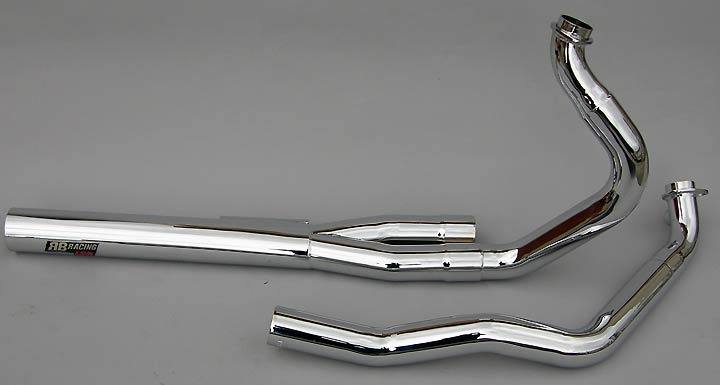
We do make one special
order header with "Steps" in it...For 50+ year old Shovelheads
(00-1381). We have to deal with an existing single bolt flange
for 1 3/4" exhaust port pockets on big inch Shovels, so we do
one short, close to the port, two step 1 3/4" to 1 7/8" to 2.0".
A 2.0" Merge Collector and 2 1/2" tail section. There was no way
to get the pipe internal volume otherwise...and we had to deal
with the oem exhaust port.
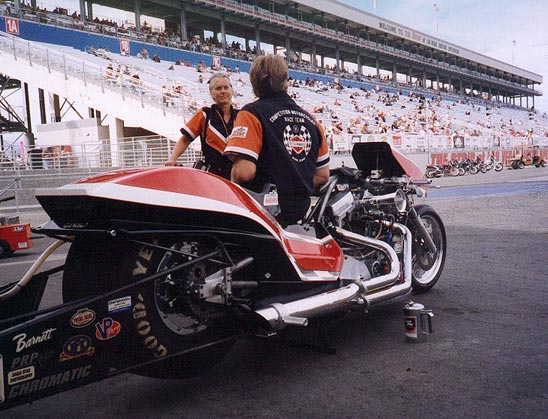
RB Racing does make some stepped designs or has
been involved in some stepped designs for Top Fuel bikes where
each cylinder is pumping out 400hp and we needed to experiment
with a 2-1 design but needed the extra volume as the Nitro was
burning well down the exhaust. There is always a problem with
bolt centers at the port so you need to start small and get big
fast. We even pulled a few new tricks to help the scavenging.
The bike's speed did increase to 214 mph but who the hell knows
what part the header played in this...It sure didn't hurt
though!
The above pictured bike
crashed in 2005 and was rebuilt later on. Carl put together another bike to test at the end of
2006. For 2007 we made a new design for
the Competition Motorcycles' Top Fuel bike. For amusement Take a Tour of what it takes to build,
maintain and race a Top Fuel Harley. For a street bike, or
any bike on gas, we cannot see any benefit from a stepped
primary tube 2-1.
Dual Exhausts
For those of you who think duals are the only
answer you are at least partially right. They don’t get the
benefit of vacuum signals from the other cylinder but they do
present an “equal” picture to each cylinder. Of course you
still have the simplistic inlet tract screwing things up but
that’s another topic. Each individual primary tube will have
its own vacuum signal both from the reflected 1600 feet per
second sonic wave as well as the slower 300 feet per second
expulsion of hot, burnt gases.
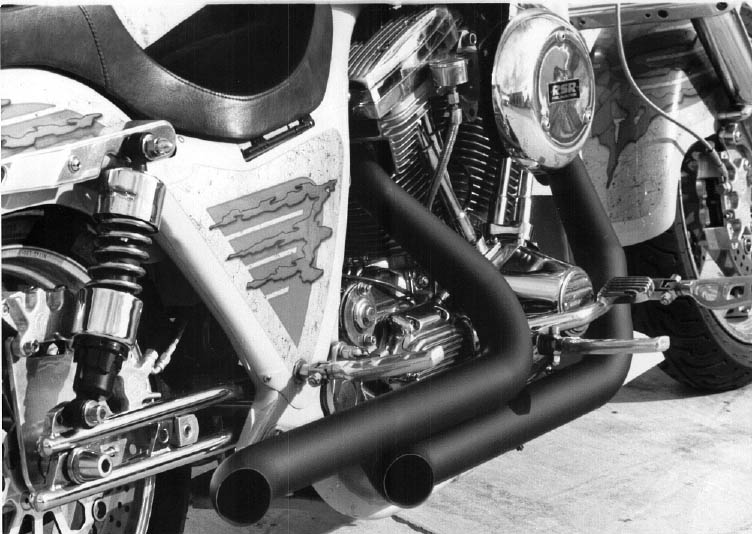
The only duals we ever made was our LSR Nitro Duals (discontinued)
which started out at 2” from our cnc machined turbo venturis and
quickly tapered to 2.5” in the first 9” after the exhaust port
by using a special seamless cone. The pipes were suited for
large bore high compression motors where the customer, for one
reason or another, did not want a 2-1 design.
The taper or cone after the port is an attempt to broaden out the powerband and to smooth the transition with no internal steps from 2 to 2.5 inches. The length of these systems had been set at about 37.5" based on actual testing. These were high flow items that were not the phony Porky pipes that all had 1 3/4” pipes pooched out in a fat step to a larger pipe, often with a flow-robbing Mig weld on the inside of the exhaust collar.
We stopped making them after 883 Sportster Owners
wanted them. They were originally made for Pro Dragster Nitro
motors and have too low a velocity for Harley street motors.
Noise...The Final Frontier
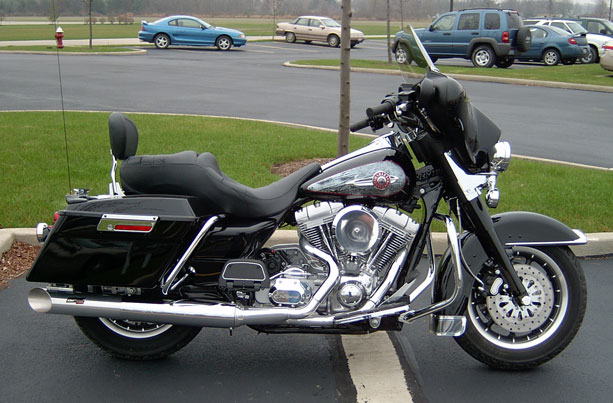
Even the "Potato Potato Potato" bursts of 45 degree V-Twin, with all its primary and collector reverberations, can be a bit much for "The Man", yourself, or your passenger if you're on a long, fast cruise. This is the old circular dilemma...Noise equals power, or, as some have rationalized... "Loud Pipes Save Lives". Well, when the man hits the Blue Lights, or your trip slowly becomes tiresome from the excessive noise, the idea of quiet power might become your goal.
Even BMW Twins get Merge Collectors
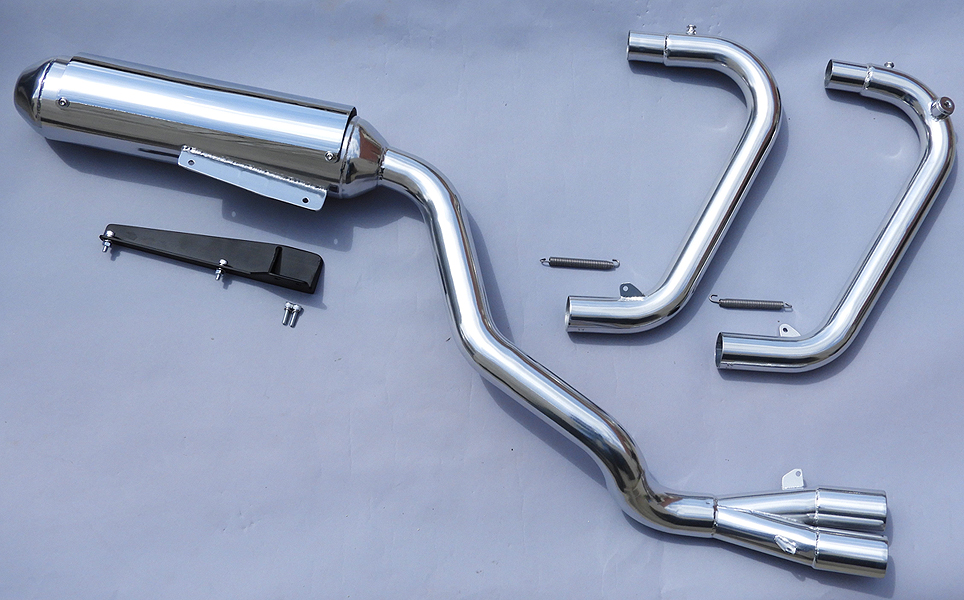
RB Racing has developed the line of LSR 2-1 Black Hole Exhaust Systems that offer quiet performance without power-robbing backpressure. These aren't race systems but they are a solution to the "Noise equals Power" equation. Pictured above is a merge collector BMW R100 Black Hole system.
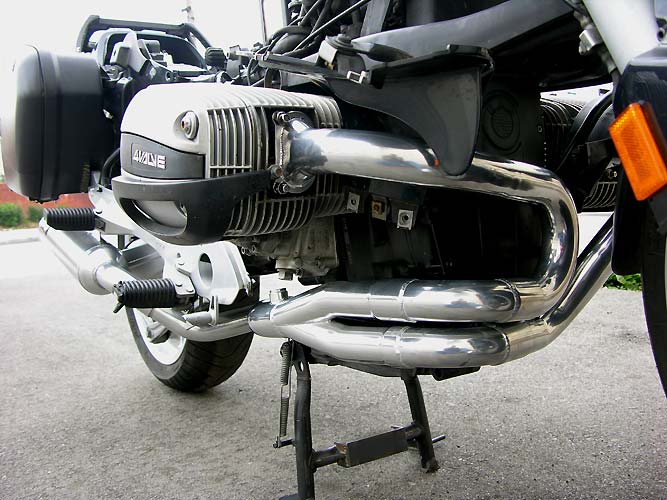
BMW R1100RT. Merge Collector with Black Hole sound cancelling technology.
Exhaust Port Dilemma...Venturi Solution
All Harley exhausts have a dilemma when it comes
to the exhaust ports. The front port points directly at the
right front downtube which means the exhaust gases see a “wall”
when they exit, as the pipe cannot have any straight section to
build inertia. All RB Racing Exhausts have “Turbo Venturis”
which are cnc machined and heliarced to the exhaust pipe.
They are designed to mate directly to a 2” pipe and require special close tolerance aircraft nuts as the usual 5/16” x 24 hex nuts won’t clear the turbo venturi as it is too wide. For our 1 3/4” primary tubes we hand-flair each tube to match the o.d. of the cnc machined venturi. This means there is no step inside the venturi to compromise the venturi’s function which is to extract exhaust gases...and no weld on the inside to compromise flow.
The Sum of All Parts
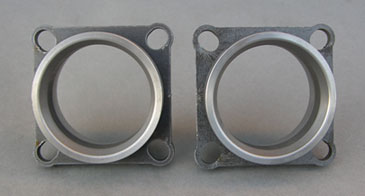
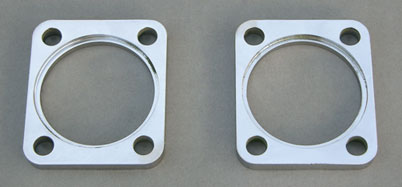
All LSR 2-1 exhaust designs employ forms of merge
collectors, venturi shaped baffles and our cnc machined exhaust
port venturis to help your engine breathe. We also make
different sizes and styles of primary tubes to meet your
specific requirement which may include either offsets for wider
tires, offsets for engine and transmissions, as well as
specialized systems for taller engines like the S&S 145”
Tribute engines. In addition, we offer special 2 and 4 bolt
flanges for both the S&S “SA” B1, B2 and B3 B2 heads as well
as for the S.T.D. 4 bolt heads (right above).
It takes over 400 part numbers not counting choices of finish or
exhaust tip design to meet these needs.
One item often overlooked is the exhaust port gasket. All LSR
exhaust systems require mandatory
billet gaskets except for our S&S “SA” and S&S
“B2” designs which can be run without gaskets. This prevents a
woven gasket from blocking the exhaust flow.
Fashion Victim or Performance With Style
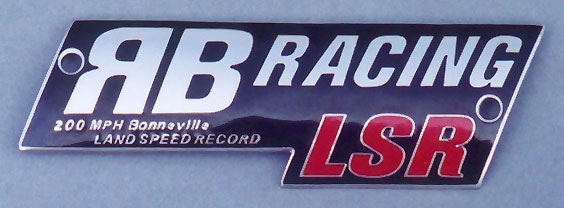
It takes a complete approach to properly address
the design of an exhaust system for a Harley-Davidson. The
alternative is simply to build copies of Hell Bent pipes or
short fat pipes or long fat pipes or some simply stupid curled
this way and that custom pipes. Like we said earlier, this is
not a logical business and although it may be tempting to go
with the style of the moment, we’ll stick to building what
actually works and try to turn out beautifully crafted, fully
TIG welded designs, that perform to the potential of your
engine. Pipes without limits that we don’t mind putting our name
on.
Multi-Variable Thoughts
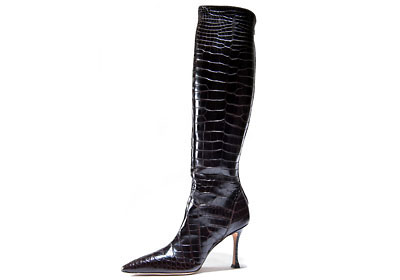
In school they taught you the scientific method where you carefully measure and document changes, one variable at a time, one change at a time. When it comes to engines and exhaust systems people dutifully get out their 1/2" and 9/16" wrenches and switch pipes and see what the new one "will do". Wrong. If you want to succeed you have to be able to change things in concert or you'll never make progress. Carburetion, fuel injection, camshafts, valve sizes, cylinder head design and components all have to work together.
If you want an analogy, tennis shoes don't play well with that slinky black evening dress. Tuners visualize the system and attack things, more than one at a time. Perhaps you change the pipe and up the carb size and work on the jetting. Maybe you dual plug the heads and put in less advance. Maybe you increase the camshaft duration to take into account the pipe will work well past 6000 rpm. Maybe you do all this at once.
Magazines dutifully bolt on one pipe after another and put the results down as gospel. What does this prove? Well it does document very well one's ability to bolt on things. The science of 9/16" and 1/2" wrenches marching towards a printed gospel...and the audience sits on the edge of their seats.
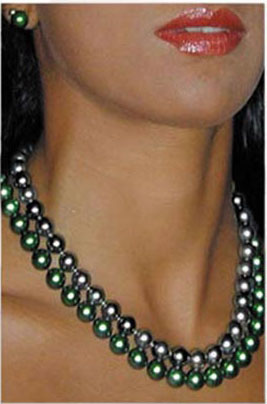
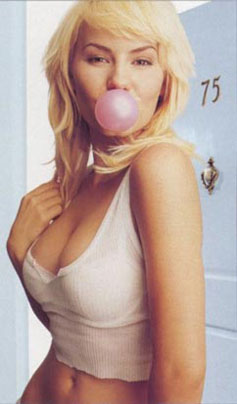
Pearls and Bubble Gum, camshafts and carburetion, exhausts and cylinder heads, evening dresses and tank tops...it's all a multi-variable problem that doesn't key on one accessory.
Get that girl a set of shoes from Manolo Blahnik. Think package, not parts.
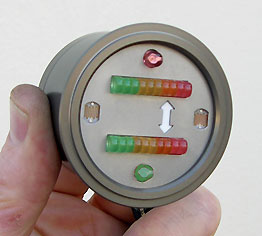
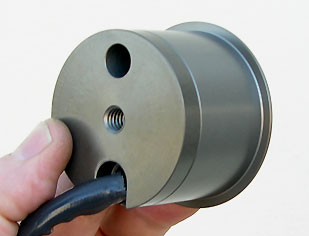
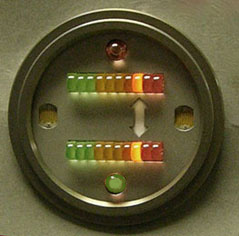
For EFi sequential injection our new RSR Dual Air Fuel Gauge displays the fuel mixture in both the front and rear cylinders separately. The gauge is housed in a hard anodized round enclosure in a standard 2" format with a 2.250" bezel, center back mount, with a 5/16" x 18 stainless socket head cap screw. The gauge will show fuel ratios from 17:1 to 12.0:1 (or richer). The gauge is visible in daylight and automatically dims for nighttime operation.
Scale is, left to right, lean to rich: three greens, three yellows, two orange and two red l.e.d.s.
The white arrow indicates the maximum power mixture, the second orange light, which is 13.2:1. Transitory enrichments should not, if the engine is warm (>200F Oil temp), go past the first red light. Readings at the far right side of the scale, the second red light, are simply too rich. Proper closed loop operation will cycle back and forth from green to orange around the center of the display.
It is simply the best way to evaluate the tune of your motorcycle and saves valuable dyno time. Mounted permanently. Waterproof.
Compatible with OEM 18mm narrowband
sensors. Can be supplied with new high temperature Bosch
narrowband sensors. Far right photo shows gauge in dim light
conditions at maximum power setting.
Final Thoughts
There is no free lunch with a 45 Degree V-Twin with 2 or 4
valves...They are piston speed limited.
One HP per Cubic Inch no matter what
the exhaust is. One HP per C.I.D. is where you should be
happy.
Anything past 1.25 HP/C.I.D. is only
picked up via higher compression, cams, etc. Think of a 100 HP
80" EVO ( 1.25 x 80). Think of a 146 HP 117" M8 (1.25 x 117).
When you get to turbos, assuming you
put on the correct turbo, it goes to 2 HP / C.I.D. at about
12-15 PSI of boost....Peaking out, with additional work, to 3 HP
/ C.I.D. with higher levels of boost.
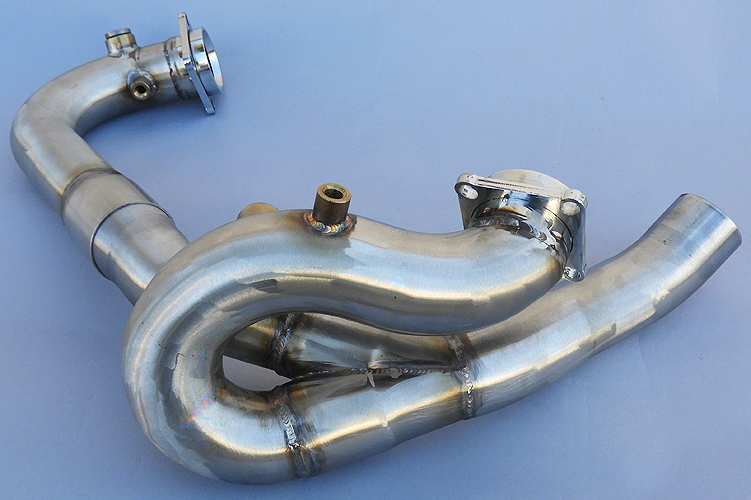
And guess what...Exhaust system
design is just as important with turbos. Merge collector, tuned
primaries, no pulses facing each other. Who knew.